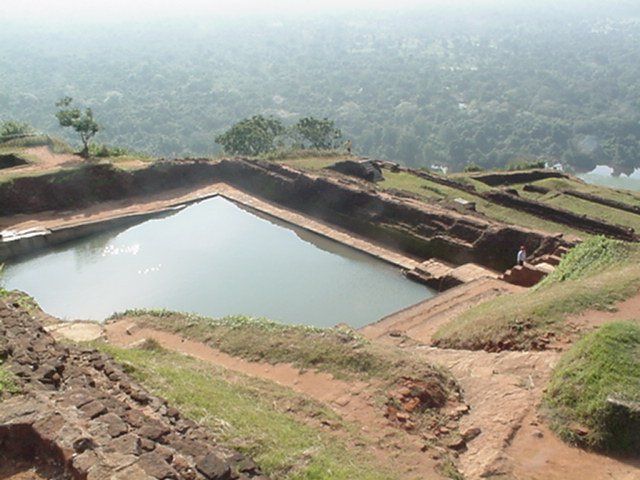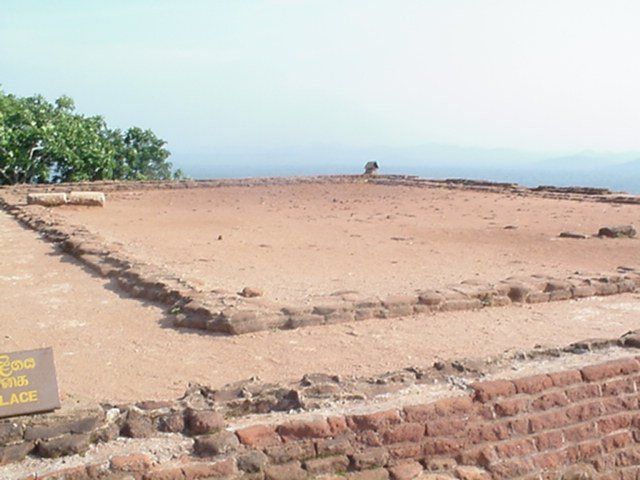
The Sigiriya Rock

Overview:
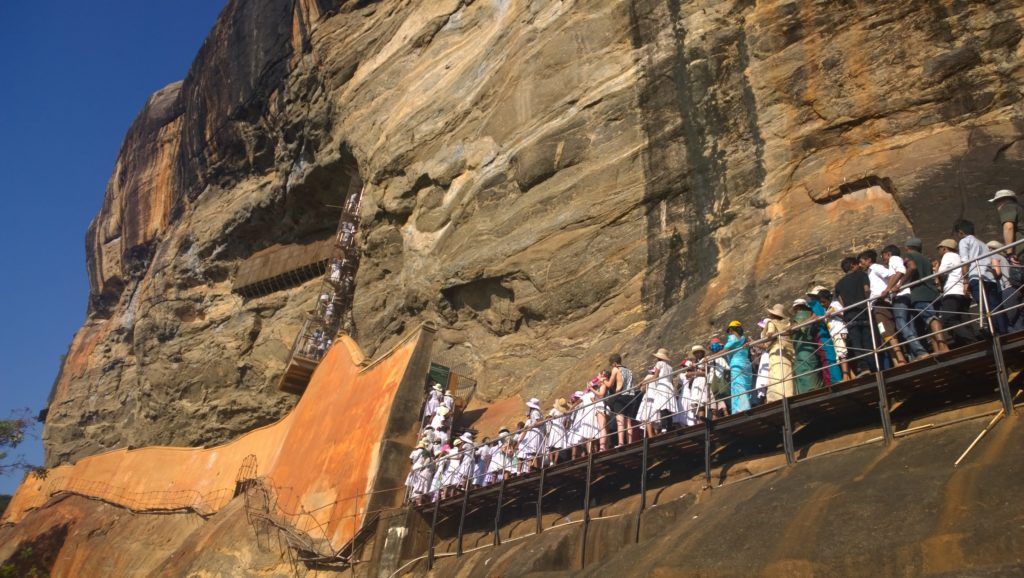 The Sigiriya Rock has four main points
of interest and can be seen in sequence by following the path that
steadily ascends the rock. Just above the walkway that hugs the western
face of Sigiriya Rock is a grotto containing the Sigiriya Frescoes.
Continuing northward brings visitors to the Mirror Wall. As the walkway
reaches the northern tip of the rock, a set of stairs leads to the Lion
Staircase. Up the Lion Staircase lies the crown jewel of Sigiriya, the
royal palace. In contrast with the lower gardens which were the private
domain of the king, this part of the complex was an imposing display of
royal power, visible for miles. The photo to the left shows this
path, which begins at the lower right hand corner and winds its way
around the side of the mountain. From there it is up a steep staircase
at the Lion's Paws to reach the summit. The sections below offer a more
detailed view of these points of interest.
The Sigiriya Rock has four main points
of interest and can be seen in sequence by following the path that
steadily ascends the rock. Just above the walkway that hugs the western
face of Sigiriya Rock is a grotto containing the Sigiriya Frescoes.
Continuing northward brings visitors to the Mirror Wall. As the walkway
reaches the northern tip of the rock, a set of stairs leads to the Lion
Staircase. Up the Lion Staircase lies the crown jewel of Sigiriya, the
royal palace. In contrast with the lower gardens which were the private
domain of the king, this part of the complex was an imposing display of
royal power, visible for miles. The photo to the left shows this
path, which begins at the lower right hand corner and winds its way
around the side of the mountain. From there it is up a steep staircase
at the Lion's Paws to reach the summit. The sections below offer a more
detailed view of these points of interest.
The Sigiriya Frescoes:
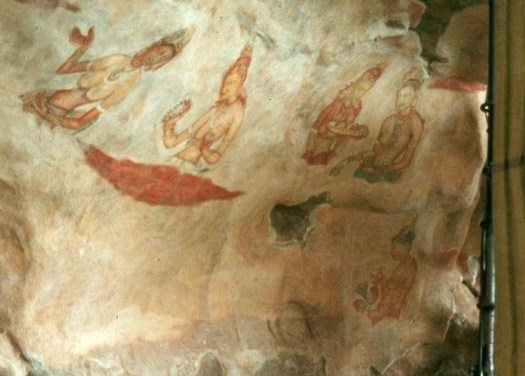 The most famous feature of the
Sigiriya complex are the fifth century paintings found in a depression
in the rock face more than 100 meters above ground level. Reached today
by a modern spiral staircase (photo to the left) they are but
fragmentary survivors of an immense backdrop of paintings that once
extended in a wide band across the western face of the rock, covering
an area 140 meters wide and approximately 40 meters high, and making it
perhaps the largest mural in the world. All that remains are a series
of maidens in two adjacent depressions in the rock, known as Fresco
Pocket A and Fresco Pocket B; the second of these is the more
accessible and contains 5 maidens in all. The photo to the right shows
Fresco Pocket B. There is a good deal of controversy over the style of
painting found in these frescoes. Considered opinion seems to argue
that they are not likenesses of maidens in Kasyapa's court or Lightning
Princesses and Cloud damsels (in keeping with the theory of Sigiriya as
a recreation of the mountain god Kuvera); rather they are asparas,
celestial beings who carried flowers and scattered them over kings and
heroes as a celebration of victory and heroism. While these are common
in art and literature throughout the subcontinent, these likenesses
represent something new in artistic terms, as they are the earliest
surviving examples of a Sri Lankan school of realism, already fully
developed by the fifth century A.D.
The most famous feature of the
Sigiriya complex are the fifth century paintings found in a depression
in the rock face more than 100 meters above ground level. Reached today
by a modern spiral staircase (photo to the left) they are but
fragmentary survivors of an immense backdrop of paintings that once
extended in a wide band across the western face of the rock, covering
an area 140 meters wide and approximately 40 meters high, and making it
perhaps the largest mural in the world. All that remains are a series
of maidens in two adjacent depressions in the rock, known as Fresco
Pocket A and Fresco Pocket B; the second of these is the more
accessible and contains 5 maidens in all. The photo to the right shows
Fresco Pocket B. There is a good deal of controversy over the style of
painting found in these frescoes. Considered opinion seems to argue
that they are not likenesses of maidens in Kasyapa's court or Lightning
Princesses and Cloud damsels (in keeping with the theory of Sigiriya as
a recreation of the mountain god Kuvera); rather they are asparas,
celestial beings who carried flowers and scattered them over kings and
heroes as a celebration of victory and heroism. While these are common
in art and literature throughout the subcontinent, these likenesses
represent something new in artistic terms, as they are the earliest
surviving examples of a Sri Lankan school of realism, already fully
developed by the fifth century A.D.
The Mirror Wall:
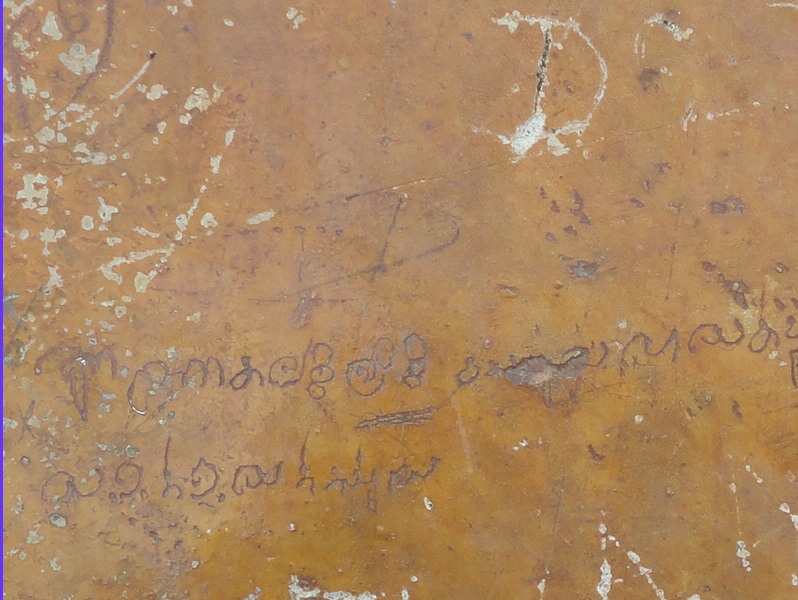 The Mirror Wall dates from the
fifth
century and has been substantially preserved in its original form.
Built up from the base of the rock itself with brick masonry, the wall
has a highly polished plaster that lends a reflective surface to the
entire wall. The Mirror Wall also includes the Sigiriya graffiti. The
origins of the graffiti can be traced to the period following Kasyapa's
rule, when people from all over Sri Lanka made pilgrimages to see the
Sigiriya Maidens as well as the gardens and the palace ruins. Inspired
by what they saw, thousands of messages have been left on the mirrored
surface of the rock. Over eight hundred of these messages have been
translated to date, revealing not only people's thoughts about the
painting themselves, but also providing insight into the sensibilities
of the ages represented in the messages. The Sigiriya graffiti offers a
portrait of Sigiriya and its meaning through the ages. The photo to the
left shows the length of the Mirror Wall, looking back toward the
Maidens, while the photo the right offers a close-up of the graffiti.
The Mirror Wall dates from the
fifth
century and has been substantially preserved in its original form.
Built up from the base of the rock itself with brick masonry, the wall
has a highly polished plaster that lends a reflective surface to the
entire wall. The Mirror Wall also includes the Sigiriya graffiti. The
origins of the graffiti can be traced to the period following Kasyapa's
rule, when people from all over Sri Lanka made pilgrimages to see the
Sigiriya Maidens as well as the gardens and the palace ruins. Inspired
by what they saw, thousands of messages have been left on the mirrored
surface of the rock. Over eight hundred of these messages have been
translated to date, revealing not only people's thoughts about the
painting themselves, but also providing insight into the sensibilities
of the ages represented in the messages. The Sigiriya graffiti offers a
portrait of Sigiriya and its meaning through the ages. The photo to the
left shows the length of the Mirror Wall, looking back toward the
Maidens, while the photo the right offers a close-up of the graffiti.
The Lion Staircase:
One of Sigiriya's most dramatic features
is the Great Lion staircase, now preserved only by the two paws and a
mass of brick masonry surrounding the ancient limestone steps. (photo
to the left) However, from the rock that remains and the records
that have been preserved, we know that the Lion Staircase was one of
the principle features of Kasyapa's design for Sigiriya, the ultimate
gatehouse to the royal palaces at the summit. His adoption of the Lion,
the mythical ancestor and royal symbol of Sri Lankan Kings, was
intended as a symbol of his might The actual structure of the
Lion Staircase House itself can be at least partially reconstructed
from the evidence still remaining at the site. The paws give a clear
idea of the form and scale of the Lion. It appears to have been created
in the crouching position, judging from the position of the paws, the
surviving pieces of what appear to be shoulders projecting from the
rock above, as well as by other cuts in the rock face. The photo at the
upper right shows the entire north face of
the rock, which would
have
been dominated by the lion's head. The photo to the lower left
provides a closer look at the existing staircase to the summit, while
the video at 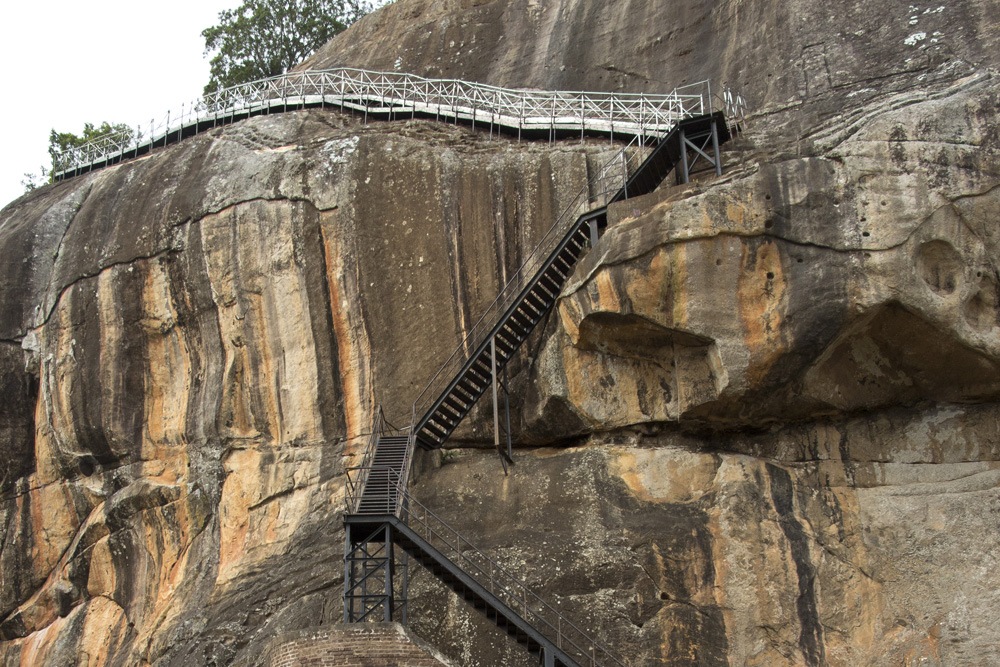
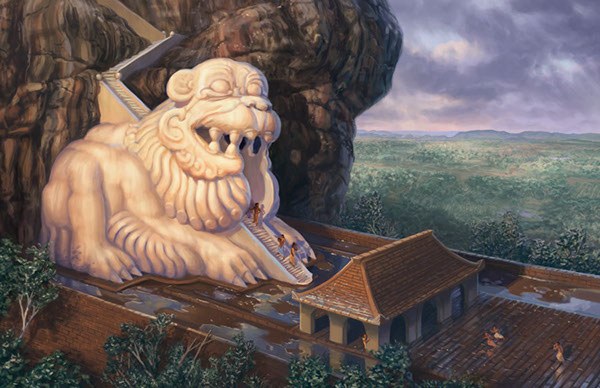 artist's recreation of what the Lion Staircase looked
like during Kasyapa's reign.
artist's recreation of what the Lion Staircase looked
like during Kasyapa's reign.
The Summit:
Summit Complex:
The summit of the Sigiriya Rock may be divided into
three distinct areas. The first, the Lower Palace area is on the
northeast side of the rock, a plateau that is accessed via the Lion
Staircase. The photo to the left overlooks two terraced areas that lead
down to the access point to the rock (Area #1 on the map above). South of the
Lower Palace area are the Palace Gardens, a series of terraced steps
that lead down to the southern edge of the mountain. The photo to the
right shows the terraces of the Lower Palace leading down to the
cut-rock tank which forms the upper boundary of the
Palace Gardens. (it is Area #2 on the map) in the illustration above) The
photo to the lower left offers a closer view of the tank, which
resembles a bathing pool but may have been used to store water. Above
the Lower Palace lies the Royal Palace area, the domain of the King.
(photo at lower right, Area #3 on the map). The palace was the center
